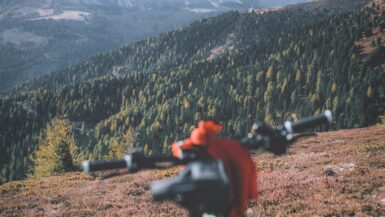Downhill riding is a thrilling experience for mountain bikers of all levels. Even for the beginner, the adrenaline pumping through your veins as you navigate the terrain and fly down the hills is unparalleled. However, the sport may seem daunting for those just beginning their ascent into the world of downhill riding. The truth is that developing the skills necessary to be a successful downhill rider can be learned with the proper instruction and practice. This article will explore the fundamentals of downhill riding, discuss the importance of training and safety, and provide tips and tricks to help you start and improve your downhill riding skills.
Readying Yourself and Your Bike
Before embarking on a downhill ride, it is essential to familiarize yourself with the terrain. This will help you know what to expect regarding obstacles, terrain changes, and route hazards. Take the time to scope out the trail or area beforehand, so you can begin to plan your route and be ready for surprises.
Master the Basics
To become an efficient downhill rider, it is vital to master the basic skills first. Make sure you grasp the fundamentals, such as cornering, braking, and body positioning. Learning to use the weight of the bike to your advantage is essential. Master the fundamentals, and you will be better equipped to handle the challenges of downhill riding.
Practice Your Skills
To become confident and competent on the trails, you should practice your downhill riding skills as much as possible. This will enable you to develop more control and finesse when maneuvering through obstacles and more challenging terrain. As you get more comfortable, you can push yourself to increase your speed and hone your skills.
Fit Your Bike Properly
A bike is an essential tool when it comes to downhill riding. It is important to properly adjust your bike’s height and weight distribution for the best control and performance. Ensure your bike is tuned and serviced regularly, and check for any wear or damage.
Choose the Right Protection Gear
When riding downhill, the right protective gear is essential. Invest in the appropriate safety gear, such as a full-face helmet, knee and elbow pads, gloves, and a back protector. Wear clothing that is both comfortable and durable, and make sure you choose shoes with good grip and support.
Physically Preparing for Downhill Riding
Before hitting the mountain, you should take the time to prepare yourself physically for the demands of downhill riding. Strengthening specific muscles essential for your time on the trails is crucial. Plyometric exercises like box jumps, squats, and single-leg deadlifts are great ways to develop lower body strength. Building upper body strength is also essential for downhill riding since you’ll be fighting the bike’s weight to keep it balanced. Do weighted or unweighted push-ups, chin-ups, pull-ups, and chest presses to build that strength.
Build Your Endurance
In addition to strength, you’ll want to build your endurance for downhill riding. Cardiovascular exercises like jogging, swimming, and cycling are great ways to increase stamina. Riding on a flat surface can also help you develop your endurance since most downhill trails have long, bumpy sections where your strength can run out. If you have access to an uphill path, try going up and down it in one session to get a good cardio workout.
Protect Your Body
No matter how fit you are, you should still protect your body from any potential accidents. Invest in quality protective gear like a full-face helmet, elbow and knee pads, and body armor. Those items will safeguard you from the falls that are inevitable when learning a new skill. If you’re concerned about how the padding will affect your performance, you can always purchase lightweight armor that won’t weigh you down.
Practice with a Partner
Going downhill with a partner can be beneficial when you’re still learning the ropes. Not only will you offer each other moral support, but you’ll also be able to help each other with techniques. A partner can also be beneficial in terms of safety. If one of you gets injured, the other can help them off the mountain or flag down assistance.
Stay Hydrated
Downhill riding can be intense and tiring, so staying hydrated while out on the trail is essential. Bring plenty of water, and a few snacks as well so you have the energy to keep riding all day long. It’s also necessary to wear sunscreen and weather-appropriate clothing to stay safe and comfortable.
Visit Different Terrains
Visit different terrains, even if you aren’t ready, to test what you learned. Some trails may be more challenging, which can help you hone your skills before moving on to more advanced courses. Make sure to take it slow and pay attention to the terrain so you don’t get over your head.
Learning the Correct Techniques
Downhill riding can be a thrilling experience and a great way to enjoy the outdoors. However, it is vital to be aware of the potential hazards of downhill riding and to make sure that you are using the proper techniques to ride safely. Before attempting to ride downhill, you must be confident in your riding abilities and learn the correct methods.
Knowing When To Ride
When considering downhill riding, it’s essential to understand when is the best time for it. Start by assessing the terrain you’ll be riding on. Make sure the trail has no rocks, roots, or other obstacles that could trip you up. Additionally, if there are steep hills and fast turns, ensure you have a good handle on the correct techniques for these sections.
Learning The Correct Techniques
Learning the proper techniques for downhill riding is essential for a safe ride. When riding downhill, make sure to practice the following techniques:
- Stay low to the ground and keep your weight centered.
- Keep your elbows and knees bent to absorb shock.
- Keep your eyes forward and use your vision to scan the terrain ahead.
- Maintain a steady speed to avoid losing momentum.
- Use the brakes sparingly and make sure to engage both brakes together.
- Always look ahead and plan your next move.
By practicing and mastering these techniques, you can gain the confidence you need for downhill riding.
Practicing With a Coach
As with any new activity, practicing and getting comfortable with the correct techniques before attempting a ride on your own is crucial. Consider taking a class with a professional instructor who can provide personalized guidance and help you further develop your skills.
Focusing on Safety
No matter how confident you feel in your riding abilities, always prioritizing safety is essential. Before hitting the trails, ensure you wear the proper protective gear, including a helmet, pads, and eyewear. Additionally, it’s important to check in with the terrain and confirm the location is suitable for downhill riding.
By following the correct techniques and prioritizing safety, you can be sure to have a great experience downhill riding. With time and practice, you’ll be able to gain the skills you need for a thrilling mountain adventure.
Mastering Advanced Techniques
Developing skills for downhill riding begins with mastering your body position. The goal while riding downhill is to remain low and centered on your bike to maintain control. Keep your weight distributed evenly across the bike, and use your arms and legs to keep your body balanced. Your hands should be slightly bent and wide, while your elbows should stay relaxed to absorb any bumps in the terrain. Your feet should remain planted in the pedals, and your knees should always be slightly bent.
Focus on Your Braking
Downhill riding requires skillful braking because you must control your speed on the descent. An experienced rider will know when and where to brake to maintain bike control. It is important to practice braking in different situations to ensure you can regulate your speed confidently. Using both the back and front brakes is recommended to practice braking to gain maximum speed control.
Practice Cornering
Cornering is another essential skill to master while downhill riding. It is important to practice cornering in various situations to gain a good sense of timing and speed. Adjust your speed before entering the corner and focus on maintaining control through the intersection by staying low and centered. Additionally, practice moving your weight to the inside of the turn to help keep your tires on the ground.
Improve Your Jumping
Finally, practicing jumps is integral to mastering advanced downhill riding techniques. When attempting a jump, practice proper body positioning while in the air. Lean forward slightly while pushing off from the lip of the jump to gain more speed and control. Keep your arms and legs bent throughout the hop to absorb the shock of landing. Landing with your weight back is another important technique to practice for successful jumps.
Tips for Riding Downhill Safely
Downhill mountain biking is an exhilarating way to experience the outdoors but it also brings a unique set of safety considerations. Following these best practices can help you to stay safe while enjoying downhill mountain biking:
Practice Before You Ride
Downhill mountain biking requires skill and practice to stay safe. Before you head out on a big downhill run, take the time to practice on small hills and slopes to get a feel for your bike and the terrain. Start slow, and gradually increase your speed as you increase your confidence.
Wear Safety Gear
It’s essential to wear the proper safety gear while downhill mountain biking. Wear a helmet, knee and elbow pads, and gloves to protect your body from potential falls and injuries. Ensure your gear fits properly and is in good condition before heading out.
Check the Terrain
Always check the terrain for obstacles and hazards before riding. Keep an eye out for rocks and roots that may cause you to wipe out. Also, avoid riding in muddy areas, as the mud can cause your tires to lose traction.
Pick Your Lines
Choose the safest line possible when riding downhill. This can involve avoiding certain obstacles, taking a different line, or changing your speed. Consider your options and plan your route before you start riding downhill.
Be Aware of Other Riders
Always be aware of other riders who may be around you. If you’re riding in a group, give others plenty of space and let them know when you’re about to pass. Always be courteous, and keep an eye out for other riders and pedestrians on the trail.
Downhill mountain biking is an exciting way to experience the outdoors. Following these best practices can help ensure you stay safe while having a great time. You can develop the skills necessary to safely and confidently take on big downhill runs with proper preparation, training, and safety gear.
The Benefits of Developing Downhill Riding Skills
Developing skills for downhill riding requires practice, technique, and experience. It can be intimidating at first, but it becomes much easier with proper knowledge and the right attitude. Novice riders must stick to primary trails to get familiar with the terrain and learn new skills. Experienced riders should challenge themselves by attempting more difficult downhill trails, gradually increasing their speed and improving their technique.
Downhill riding can be an enjoyable and rewarding experience when done correctly. It can be an incredible adrenaline rush and help develop athleticism and balance skills. Beyond this, it can also build confidence in tackling more challenging trails and complex conditions that may be encountered in the future. With practice, dedication, and a great attitude, anyone can learn to conquer the downhill challenge and become a skilled rider.






Leave a reply